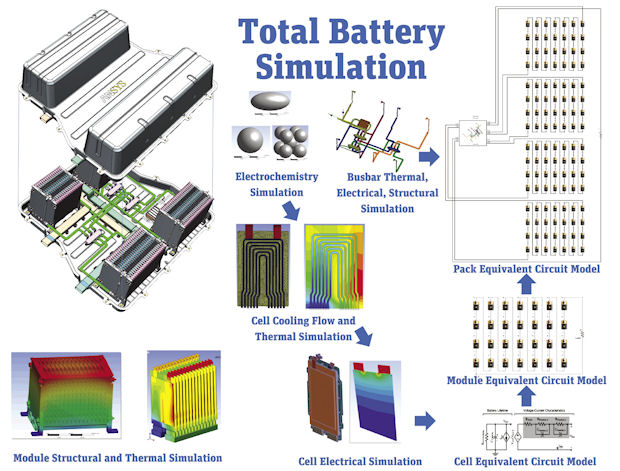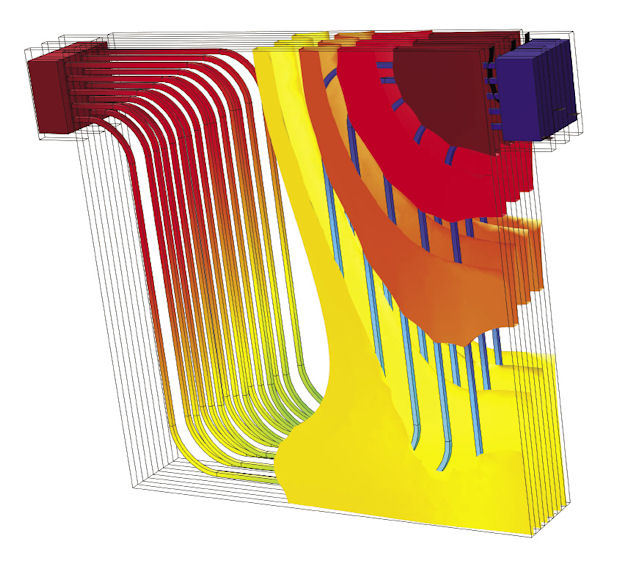
All levels—cell, module and battery-pack—and physics effects—electrochemistry, mechanical, thermal—for an automotive Li-ion battery are handled by ANSYS Multiphysics software. Image courtesy ANSYS.
June 1, 2014
 All levels—cell, module and battery-pack—and physics effects—electrochemistry, mechanical, thermal—for an automotive Li-ion battery are handled by ANSYS Multiphysics software. Image courtesy ANSYS.
All levels—cell, module and battery-pack—and physics effects—electrochemistry, mechanical, thermal—for an automotive Li-ion battery are handled by ANSYS Multiphysics software. Image courtesy ANSYS.Gears are a symbol of engineering, and though many projects involve more than mechanical considerations, gears offer a relevant perspective: turn one, and its neighbor, and the next one also respond. Think about automotive design in the same way, and that connectedness grows to include electrical and chemical behavior modulated by a dose of thermal response. If you don’t understand how the physics of one affects the other, your design won’t make it out of the garage.
Even then, great performance isn’t enough. Keeping down costs while speeding up time to market—these are the kinds of challenges that lead Bernt Nilsson, COMSOL senior vice president of marketing to observe, “There’s a lot of pressure to be productive with creative designs; you have to be at the front of the industry.” For the automotive electronics world, that means applying multiphysics tools and really understanding the results, especially in two critical subsystems: lithium-ion batteries and micro-electro-mechanical systems (MEMS)-based sensors and actuators.
Batteries Taking the Heat
Compared to its counterpart of 10 or 20 years ago, today’s lithium-ion cell-phone battery seems a work of genius. But the challenges faced by engineers transferring this basic technology to large-scale automotive applications calls for even more creative skills backed by solid analysis tools. Nothing less will yield the details necessary to design the cathodes, anodes, electrolytes, barriers, housing and cooling systems. Software for simulation and optimization must balance often-conflicting specifications for safety, durability, charging time, output power, energy density, operating temperature and cost of materials.
As an example of the ripple effect of these characteristics, a recent webinar by Mentor Graphics on using FloEFD for Siemens NX to evaluate vehicle battery-pack cooling had a broad audience. The “who should attend list” included battery-pack design engineers, mechanical engineers, powertrain cooling engineers, hybrid vehicle propulsion engineers, battery simulation/modeling engineers, thermal systems engineers and design engineers. Each has a role to play, but how best to do it?
First things first. “With batteries, MEMS and really anything multiphysics, you always have to the get the single physics right before you can get the multiphysics right, and you have to have a lot of confidence in it,” says Chris Wolfe, ANSYS lead product manager for multiphysics. She notes that this accuracy is one of ANSYS simulation software’s strengths.
In the operation of lithium-ion batteries, multiphysics apply to several aspects. To supply the necessary power for vehicles, individual cells are connected in a series, creating modules, then modules are connected together to form a battery pack, all of which must conform to a hybrid or electric vehicle chassis. Whether a combination of consumer-type cylindrical batteries used in the Tesla (7,000 of them in the 85KWh pack), or the 288 rectangular cells of the Chevy Volt, the compact physical layout combined with the exothermic chemical reactions that generate electrical power produces heat, which can impact performance.
“You have to make sure the casing doesn’t heat up too much and deform,” Wolfe explains. To analyze this “a lot of [finite element analysis] FEA packages use models or an empirical convective heat-transfer coefficient. That’s OK for a lot of things, but it doesn’t take into consideration actual turbulence that’s happening around the battery—it’s just an estimate. If you really want to understand what’s going on from a thermal perspective, you need to look at the fluid flow and how the convective cooling in addition to the conductive cooling is pulling heat away from your device. With ANSYS, you can strongly pull all the physics together to get the best possible high fidelity representation.” She says that they’ve actually seen a 10 to 20% difference in results when comparing estimated vs. calculated coefficients.
Bob Spotnitz is a 30-year-veteran in the field of battery design. He’s seen automotive applications come, go and finally gain significant market penetration with both hybrid and plug-in vehicles. As the president of Battery Design LLC, and now a consultant to computational fluid dynamic (CFD) analysis company CD-adapco, Spotnitz and CD-adapco have pushed their Battery Design Studio (BDS) software to new capabilities. “Even five years ago,” he says, “accounting for non-uniform heat generation just wasn’t possible. You just had to overdesign (a battery), adding a huge safety margin for long life. Now, you can design much more economically, because your confidence in the design is much higher. That’s the major advance.”
 Temperature field in an automotive battery pack, simulated with COMSOL Multiphysics software. The model includes a high-fidelity electrochemical model of the batteries coupled to a thermal analysis for the batteries and the components in the battery pack, plus the fluid flow in the cooling channels. Image courtesy COMSOL.
Temperature field in an automotive battery pack, simulated with COMSOL Multiphysics software. The model includes a high-fidelity electrochemical model of the batteries coupled to a thermal analysis for the batteries and the components in the battery pack, plus the fluid flow in the cooling channels. Image courtesy COMSOL.Battery simulation code is compiled directly in CD-adapco STAR-CCM+ software and just “turned on” with a switch upon purchase. BDS lets you define cell-level details (e.g., electrode geometry, chemistry formulation and packaging) then calculate such characteristics as volume, weight and energy density. STAR-CCM+ also incorporates a Battery Simulation Module (BSM) that imports the cell geometry for CFD analyses, coordinating the physics of electrical, chemical and thermal aspects. Users can perform tightly coupled CFD simulations over multiple cells, evaluating different battery module/pack configurations, and even including thermal interactions with other vehicle components. Adding mechanical effects such as vibration is worked through third-party packages such as SIMULIA’s Abaqus.
Once a basic design is chosen, Spotnitz says the software provides a number of routes for design-of-experiments and optimization. “With BDS,” he notes, “CD-adapco has extended its functionality making it interoperable with (MathWorks’) MATLAB Simulink to evaluate different control strategies. It has also partnered with (and last year acquired) Red Cedar HEEDS optimization software. Within STAR-CCM+, HEEDS is incorporated as an add-on product called Optimate. For example, for cooling channels, you can figure out the optimal diameter to minimize pressure drop but maximize temperature uniformity.”
[gallery columns=“1” link=“none” ids=”/article/wp-content/uploads/2014/05/MSCSoftwaremicroactuat_opt_620.jpeg|,/article/wp-content/uploads/2014/05/MSCSoftwaremicro_mesh_opt1_620.jpeg|,/article/wp-content/uploads/2014/05/MSCSoftwaremicroactua_opt1_620.jpeg|,/article/wp-content/uploads/2014/05/MSCSoftwaremicro_mesh__opt_620.jpeg|Coupled electrical-thermal-mechanical analysis of a MEMS-based microactuator (approximately 200 microns long), performed with MSC Software Marc software. Temperature-dependent material properties require nonlinear analysis to accurately model the complex behavior. As electricity passes through the actuator, the thinner beam gets hotter and expands more. It tries to bend, applying force on the other end of the actuator. When electric flow is discontinued, the actuator cools and returns to its original shape. Images show models and meshing for stress (top two) and thermal analyses. Typical automotive applications for such actuators include microvalves and dispensers in engines. Images courtesy MSC Software.”]
Another analysis source comes from COMSOL Multiphysics software. Its Batteries & Fuel Cell Module provides a detailed description of electrochemical phenomena, such as ion transport and electrokinetics, which are used for physical modeling of the governing processes in lithium ion batteries. Henrik Ekstrom, COMSOL product manager, says such models can, for instance, provide spatially resolved heat sources during power cycling of a battery. “By combining heat transfer and battery chemistry modeling,” he says, “various aspects of cooling, thermal management and thermally induced battery-aging can be studied.”
Alongside all the electrical, structural and thermal issues, proper mechanical sealing of battery units is critical. Srinivas Reddy, MSC Software senior product marketing manager, points out that since the components expand due to the heat generated during the chemical reaction, it is important the seals are effective over a wide temperature range. He says, “Ineffective sealing can lead to leakage of corrosive chemicals, leading to hazardous conditions and premature failure of the batteries. Using finite element solvers like Marc (MSC Software’s nonlinear simulation package) users can model the complex electrical-thermal-structural coupling behavior.”
Micro-sensors and Micro-actuators
A different but equally active area of automotive engineering is the world of micro-electro-mechanical systems (MEMS) sensors and actuators, which convert one form of energy to another resulting in dozens of useful applications. Based on piezoelectric (strain-measuring) and capacitance-sensing technology, these millimeter- to micron-scale devices are vital components for airbag deployment, tire-pressure monitoring, stability control, active suspension and more.
Multiphysics simulations play a critical role in the effective design of these devices, which by their nature display combinations of electrical, mechanical and thermal behavior. To support this need, COMSOL Multiphysics software offers a MEMS Module that can model electromechanical actuation, piezoelectric devices, capacitive sensing and resonant devices. Accommodating the fine details is critical. For example, since electrostatic forces can deform a solid, the software accounts for nonlinear geometric effects. COMSOL product manager James Ransley says that in addition, “Damping is often critical in the design of accelerators and gyroscopes; consequently (with COMSOL) detailed modeling of thin-film damping is possible at both atmospheric pressure and at the reduced pressures applicable for vacuum packaged devices.”
In support of efficient design optimization, updates to CAD drawings can be automated and controlled either by a parametric sweep or the COMSOL optimization solver. “The user can adjust all the parameters of CAD geometry from inside the COMSOL Desktop,” says COMSOL Sales Manager Winfried Geis, “using either the built-in geometry capabilities of COMSOL Multiphysics or one of its LiveLink interfaces. COMSOL supports distribution on a cluster or in the cloud, and uses shared and distributed memory parallelism for each model run to squeeze out maximum hardware performance.”
ESI Group is another company with deep experience in the automotive world, recently celebrating 40 years in engineering analysis, beginning with crash analysis and now including fuel-cell design as well as MEMS technology. Its ACE+ Suite of CFD and multiphysics solutions covers a broad range of physics including flow, heat transfer, stress/deformation, chemical kinetics, electrochemistry, electrostatics, electromagnetics and microelectronics, coupled in any combination, for analyzing MEMS and microfluidic devices. Applications include accelerometers, micromirrors, gyroscopes, pressure sensors and shock sensors.
More Info
Subscribe to our FREE magazine, FREE email newsletters or both!
About the Author
Pamela Waterman worked as Digital Engineering’s contributing editor for two decades. Contact her via .(JavaScript must be enabled to view this email address).
Follow DE





